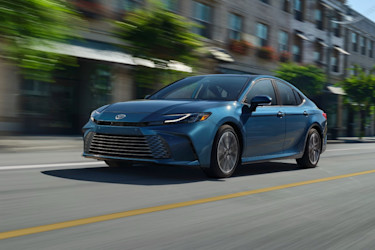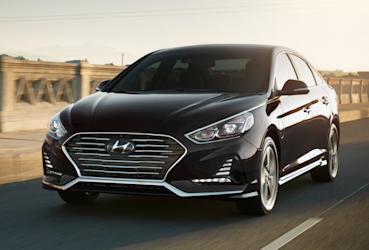The Kia K5 is the Korean carmaker's entrant in the midsize sedan class. The K5 name has been around since 2010 in its home market and China, but it didn't reach the U.S. market until 2021 when it replaced the Optima. It followed the Optima's lead by offering an attractive and affordable alternative to the established class stalwarts including the Honda Accord, the Toyota Camry, and the Nissan Altima.
As is customary with many Kia vehicles, the K5 shares its platform with an equivalent Hyundai, in this case, the Sonata. From 2000 to 2009, the Kia Optima was nearly identical to the Sonata, but the big change happened with the 2010 redesign. Under the direction of former Audi design boss, Peter Schreyer, the Optima developed its own personality, with more appealing and cohesive exterior styling.
Other Kias have received the same treatment, elevating the brand from an afterthought to a class leader. It represents one of the most impressive automotive turnarounds for any manufacturer and has forced rivals to up their game in a similar manner.
Kia K5 Buying Guide: Cost, Reliability, and the Best Years to Buy
Frequently Asked Questions
Which Kia K5 years are the best?
The Kia K5 hit the ground running when it debuted in 2021 and earned class-leading status among critics. It has since seen only minor changes that mostly amounted to a few additional features and shuffling equipment between trim levels. It wasn't until the 2025 model year that the K5 received a refresh that included subtle exterior styling changes, a more noticeable interior makeover, a larger infotainment touchscreen, and a different base engine. It didn't represent a huge improvement, but those few upgrades were enough to push the 2025 K5 to the top of our list.
Which Kia K5 years are the worst?
With its relative youth and the lack of significant changes over most of its production run, there isn't a particular model year that stands out from the rest. Regarding official recalls, the inaugural 2021 K5 had the most, which is common for almost any vehicle. These involved a possible fuel leak, an unexpected loss of engine power, and some power steering and airbag issues. These have been incrementally addressed over the years and were fully resolved by 2024. As long as a K5 has been checked for recall resolutions, we'd have no issue considering it a solid used vehicle pick. For this reason, we suggest confirming the results with a Kia dealer as well as checking the vehicle identification number (VIN) on the NHTSA website.
Is a used Kia K5 a good deal?
Based on available data, the Kia K5 has maintained high scores for reliability and dependability since its U.S. debut. Kia and Hyundai both benefit from a very generous 10-year/100,000-mile powertrain warranty that adds a considerable amount of shopper confidence, but it's important to note that this warranty only applies to the original owner. The next owner's warranty drops to an industry-average five-year/60,000-mile plan if that time and mileage haven't been exceeded. Current data also points to the K5 retaining a good amount of its value. After three years of ownership, you could expect the resale value to drop about 27 percent from its original purchase, which is slightly better than the average midsize sedan’s. Depreciation accelerate a little at five years, with expectations in the 45 percent range, which isn't as favorable as the class average of 40 percent, but the Kia K5 is an admirable used sedan regardless of its depreciation against rivals.
Kia K5 Pros and Cons
Pros:
- Stylish design
- Fun to drive
- Excellent value for the money
Cons:
- No hybrid option
- GT trim isn't as sporty as advertised
- Larger wheels negatively affect comfort
Kia K5 Generations
First Generation (2021-Present)
The Kia K5 is a similar size to the fourth-generation Optima it replaced, and the Optima was already one of the sportier-looking sedans in its class, but the K5 took it even further. Narrow LED headlights peer out from an inset grille, partially covered by the brow of the hood, giving the front of the K5 a purposeful and almost sinister personality. At the rear, taillights with available LED “dashes” span the width of the deck lid.
The profile is equally sporty, thanks to a sleek, fastback-like roofline. Despite appearances, the trunk opens like a standard sedan’s rather than a hatchback’s. Rear-seat space is adequate for adults, but the panoramic sunroof eats into headroom, and passengers need to mind the lower roof when they’re getting in and out.
The 2021-2024 K5s featured analog gauges and an eight-inch infotainment touchscreen, with a larger 10.25-inch available. The 2025 refresh added a digital instrument panel integrated into a wide, horizontal enclosure that blends into a standard 12.3-inch infotainment screen. The climate controls below were fairly traditional in the first few years, with physical buttons and knobs, but the 2025 K5 incorporated a multi-function panel, familiar from other Kia vehicles. With a tap of one of the icons, the controls switch between climate and audio/navigation shortcuts, so it's a clever use of space, but more distracting to operate when driving.
The interior materials are comparable to other sedans in the class, benefitting from plenty of soft-touch surfaces and a sturdy construction. There are still some hard plastics, but they're located in less obvious areas of the cabin, and well textured to match the rest of the surfaces. Unlike some sedans, genuine leather upholstery isn’t available, but the synthetic substitute is convincing enough.
The trunk can hold up to 16 cubic feet of cargo, which is larger than average for the class, and its wide opening and low height make it easy to load bulky items, while remote seatback releases simplify expanding that space into the rear seats. The 2025 models drop to 15.6 cu-ft, but we doubt anyone will notice.
The K5 was initially available with two engines. The base model had a 1.6-liter turbocharged four-cylinder engine that produced 180 horsepower and 195 pound-feet of torque. An eight-speed automatic transmission sent power to the front wheels, and all-wheel drive was available on the LXS and GT-Line trims, which was somewhat unusual for the class. For the 2025 refresh, the base engine was replaced with a 2.5-liter non-turbocharged four-cylinder engine. Horsepower increased to 191, but torque dropped slightly to 181 lb-ft.
The GT model upgraded to a 2.5-liter turbocharged engine increased specs to 290hp and 311 lb-ft of torque. An automated dual-clutch transmission replaced the standard automatic and added steering wheel-mounted paddle shifters.
The base engine wasn't impressive, but it was more than adequate for most drivers, and would take about eight seconds to accelerate to 60 mph, which is expected of most midsize sedans. Handling isn't quite as sporty as the K5's styling suggests, but it corners with confidence, and the ride is comfortable.
The GT may seem like the choice for spirited drivers, reaching 60 mph in only six seconds, but that doesn't tell the whole story. It's not available with all-wheel drive, so all that power tends to overwhelm the front tires. The sport-tuned suspension allows for a sharper driving experience, but the moment you start feeding in more power, the front wheels spin freely, forcing you to wait until you're pointed straight ahead to get on the accelerator.
As for fuel economy, the Kia K5 is about average for the class. The base engine had an EPA estimate of 29 mpg city and 38 mpg highway. Adding all-wheel drive reduced those figures to 26 mpg city and 34 mpg highway, while the more powerful GT was estimated at 24 mpg city and 32 mpg highway. Some of these estimates have been adjusted over the years, losing between one and two mpg, depending on engine choice, but there’s little in that in the real world. The non-turbo base engine introduced in 2025 is estimated at 26 mpg city and 37 mpg highway in the front-wheel-drive configuration. All-wheel-drive is rated at 24/33 city/highway mpg. There is no hybrid option with the K5, as there is with some competitors.
In its debut year, the 2021 Kia K5 trim levels included the LX, LXS, GT-Line, EX, and GT models. The base LX featured cloth upholstery, wireless Apple CarPlay and Android Auto, dual-zone climate control, and 16-inch alloy wheels (optional 18- and 19-inch wheels came with sporty Pirelli P-Zero tires). The LXS added keyless entry and push-button start (there was also an optional smart key offering remote start), split-folding rear seats, and remote vehicle monitoring and control via the Kia Connect smartphone app.
The K5 GT-Line gave buyers a sportier-looking alternative without the top GT's engine upgrade, with gloss black exterior body styling elements, such as a rear spoiler and larger wheels. The EX was the luxury choice in the lineup, with a standard panoramic sunroof, heated and ventilated front seats, Syntex synthetic leather upholstery, and a wireless phone charger. Along with the engine upgrade, the GT added stronger brakes, firmer suspension, front sport seats, and similar styling themes as the GT-Line. Adaptive cruise control, a larger infotainment touchscreen, a Bose premium audio system, and a heated steering wheel were optional.
In 2022, the K5 added an optional surround-view camera, and an available GT-Line AWD Premium package with a panoramic sunroof, a heated steering wheel, LED projection headlights, and additional driver assistance features including highway driving assist and navigation-based smart cruise control. The entry-level LX trim was discontinued in 2023, while refinement increased on the higher trims, thanks to sound-insulated front windows. The only change for 2024 amounted to heated seats added to the GT-Line trim. The 2025 refresh made only slight exterior tweaks, with most of the big changes taking place inside and under the hood.
Throughout its production run, the Kia K5 received a five-out-of-five overall safety rating from the National Highway Traffic Safety Administration (NHTSA), with four stars for frontal crash and rollover protection. The Insurance Institute for Highway Safety (IIHS) also awarded the K5 its highest score of "Good" in all crash tests except for the updated side impact test, where it scored a second-worst "Marginal" rating. Despite this, the 2021 and 2022 K5 were named a Top Safety Pick+, the Institute's highest honor. The IIHS added an updated moderate frontal overlap test in 2023, in which the K5 was rated the lowest score of "Poor".
As is customary with modern vehicles, Kia K5 models have been equipped with all of the typical advanced safety features. These included frontal collision warning with automatic emergency braking and pedestrian detection, lane-keep assist, and a driver attention monitor for the base LX trim. The LXS added blind-spot collision-avoidance assist with rear cross-traffic collision-avoidance assist, and a safe exit assist system, while the EX added rear parking proximity sensors. Adaptive cruise control was available as an option on certain trims, as was a parking collision avoidance system with a rear-view camera. A surround-view camera system was added to the options list in 2022, along with front parking sensors and automatic emergency braking while in reverse.
Kia’s blind view monitor system was added to higher trims in 2025, but it can be more of a distraction than a help. When a turn signal is activated, a live video feed of that side's blind spot is projected in the instrument panel. It's intended to show you if a vehicle is lurking back there, but it can draw your attention to the dash and away from the road, which is not a good thing when changing lanes or making a turn, and it can be especially distracting at night.
Pre-owned K5 prices have remained strong compared to the average for the class. For example, a 2021 K5 EX trim had an MSRP of around $30,000 when new. Three years later, prices for the same car with around 45,000 miles were between $20,000 on the low end and $23,000 for one in excellent condition. The 2025 refresh will likely not affect older K5 pricing significantly, because the powertrains are similar, and there aren't any notable additions, aside from the new interior.



